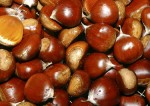 As the Christmas song tells us, “Chestnuts roasting on an open fire…Help to make the season bright.” To many, however, chestnuts have been a staple food rather than a holiday treat. They have a long and interesting history and have played a key role in many different cultures.
As the Christmas song tells us, “Chestnuts roasting on an open fire…Help to make the season bright.” To many, however, chestnuts have been a staple food rather than a holiday treat. They have a long and interesting history and have played a key role in many different cultures.
1. Chestnuts have been cultivated for over 4000 years.
2. To the early Christians, chestnuts symbolized chastity.
3. In Turkey and parts of Europe and Asia chestnuts replaced cereals as a source of carbohydrates.
4. In Japan, Italy, and France, chestnuts have traditionally been the food of the poor.
5. Chestnuts are the only nuts that contain vitamin C.
6. In Japan, chestnuts represent mastery and strength and are traditionally served at New Years.
7. Roasting chestnuts for eating is popular in northern China, Korea, Southeast Asia and Turkey as well as parts of Europe.
 8. China produces more than twice as many chestnuts as its closet competitor, Turkey.
8. China produces more than twice as many chestnuts as its closet competitor, Turkey.
9. The United States produces only 1% of the world supply and must important chestnuts, mostly from southern Italy, to meet the demand. Sicilian chestnuts are most highly prized.
10. The chestnut tree of One Hundred Horses growing on Mount Etna in Sicily is largest and oldest known chestnut tree in the world. It is between 2,000 and 4,000 years old and 190 feet in circumference.